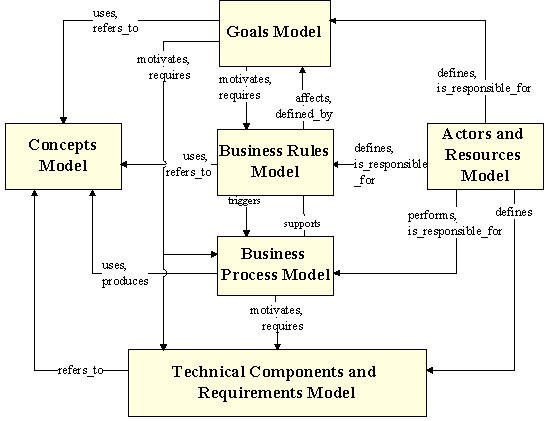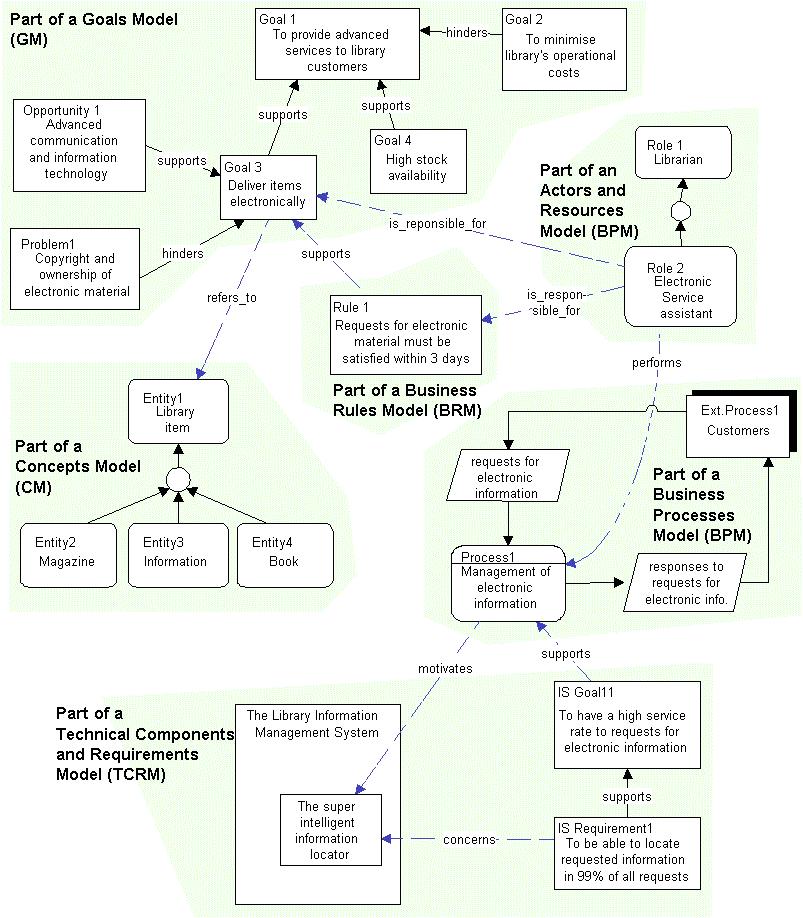EKD - Enterprise Knowledge Development
-
EKD IS an integrated collection of methods, techniques, and tools that
will support your process of analysing, planning, designing, and
changing your business.
-
EKD supports your thinking, reasoning, and learning about the business.
-
EKD leads to more complete and consistent business designs.
What EKD is not?
-
a “magic method” that relieves you from thinking and acting
-
a “software tool”
-
an approach that necessarily leads to a software system
EKD framework

Goals Model (GM)
GM focuses on describing the goals of the enterprise. Here we describe
what the enterprise and its employees want to achieve, or to avoid, and
when. Goals Models usually clarify questions, such as: where should the
organisation be moving, that are the goals of the organisation what are
the importance, criticality, and priorities of these goals, how are goals
related to each other, which problems are hindering achievement of goals.
Business Rule Model (BRM)
BRM is used to define and maintain explicitly formulated business rules,
consistent with the Goals Model. Business Rules may be seen as operationalisation
or limits of goals
Business Rule Model usually clarifies questions, such as: which rules
affect the organisation’s goals, are there any policies stated, how is
a business rule related a goal, how can goals be supported by rules.
Concepts Model (CM)
CM is used to strictly define the "things" and "phenomena" one is talking
about in the other models. We represent enterprise concepts, attributes,
and relationships. Concepts are used to define more strictly expressions
in the Goals Model as well as the content of information sets in the Business
Processes Model.
Concepts Model usually clarifies questions, such as: what concepts
are recognised in the enterprise (including their relationships to goals,
activities and processes, and actors), how are they defined, what business
rules and constraints monitor these objects and concepts.
Business Processes Model (BPM)
BPM is used to define enterprise processes, the way they interact and the
way they handle information as well as material. A business process is
assumed to consume input in terms of information and/or material and produce
output of information and/or material. In general, the BRM is similar to
what is used in traditional data-flow diagram models.
Business Process Model usually clarifies questions, such as: which
business activities and processes are recognised in the organisation, or
should be there, to manage the organisation in agreement with its goals?
How should the business processes, tasks, etc. be performed (workflows,
state transitions, or process models)? Which are their information needs?
Actors and Resources Model (ARM)
ARM is used to describe how different actors and resources are related
to each other and how they are related to components of the Goals Model,
and to components of the Business Processes Model. For instance, an actor
may be the responsible for a particular process in the BPM or, the actor
may pursue a particular goal in the GM.
Actors and Resources Model usually clarifies questions, such as: who
is/should be performing which processes and tasks, how is the reporting
and responsibility structure between actors defined?
Technical Components and Requirements Model (TCRM)
TCRM becomes relevant when the purpose of EKD is to aid in defining requirements
for the development of an information system. Attention is focused on the
technical system that is needed to support the goals, processes, and actors
of the enterprise. Initially one needs to develop a set of high level requirements
or goals, for the information system as a whole. Based on these, we attempt
to structure the information system in a number of subsystems, or technical
components. TCRM is an initial attempt to define the overall structure
and properties of the information system to support the business activities,
as defined in the BPM.
The Technical Components and Requirements Model usually clarifies questions,
such as: what are the requirements for the information system to be developed,
which requirements are generated by the business processes, which potential
has emerging information and communication technology for process improvement.
Relationships between sub-models
Each of these sub-models includes a number of components describing different
aspects of the enterprise. For example, the Goals Model contains business
goals, business problems, divided into threats and weaknesses, causes,
business opportunities, and constraints. The modelling components of the
sub-models are related between themselves within a sub-model (intra-model
relationships), as well as with components of other sub-models (inter-model
relationships).
Figure above shows inter-model relationships. The ability to
trace decisions, components and other aspects throughout the enterprise
is dependent on the use and understanding of these relationships. When
developing a full enterprise model, these relationships between components
of the different sub-models play an essential role. For instance, statements
in the Goals Model allow different concepts to be defined more clearly
in the Concepts Model. A link is then specified between the corresponding
Goals Model component and the concepts in the Concepts Model. In the same
way, goals in the Goals Model motivate particular processes in the Business
Processes Model. The processes are needed to achieve the goals stated.
A link therefore is defined between a goal and the process. Links between
models make the model traceable. They show, for instance, why certain processes
and information system requirements have been introduced. The figure below
shows a fraction of an enterprise model. Inter-model links are shown with
dashed arrows.

There exist, however, limitations in the way sub-models and their relationships
may be populated. These are controlled by a number of static as well as
dynamic consistency rules, which control their permissible state transitions.
These are necessary because they allow for analysis and comparison. How
each sub-model focuses on a specific view of the enterprise will be described
in detail in the following chapter.
[BACK]


